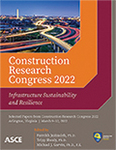Transitioning to the Next Era of Modular Construction: Reconfiguration, Reuse, and Building Stock Agility
Publication: Construction Research Congress 2022
ABSTRACT
The current era of modular building construction has been largely immutable for the past century in terms of its aspirations, drivers, and objectives. Delivering prompt, cost-effective, and high-quality assets has characterized this era. Yet, a new era is emerging—centered on the post-asset-delivery phase, espoused by prominent circular economy principles. The ability to reconfigure and reuse modular building assemblies in a highly agile manner poses significant opportunities for revolutionizing the environmental and economic impacts of our ever-growing built environment. This paper establishes the groundwork for transitioning toward the next era of modular construction. First, a review of current efforts being made to facilitate this transition is identified. Then, using additional inputs from the industry, a People, Process, Technology (PPT) framework is used to summarize current drivers and constraints. This research provides a cross-sectional analysis of where the modular industry is and how it can transition into its next era.
Get full access to this article
View all available purchase options and get full access to this chapter.
REFERENCES
Abdul Nabi, M., and El-Adaway, I. H. (2020). “Modular Construction: Determining Decision-Making Factors and Future Research Needs.” J.Manage.Eng., 36(6), 04020085.
Arisya, K. F., and Suryantini, R. (2021). “Modularity in Design for Disassembly (DfD): Exploring the Strategy for a Better Sustainable Architecture.” IOP Conference Series: Earth and Environmental Science, IOP Publishing, 012024.
Bock, T., and Linner, T. (2015). Robotic industrialization. Cambridge University Press.
Boje, C., Guerriero, A., Kubicki, S., and Rezgui, Y. (2020). “Towards a semantic Construction Digital Twin: Directions for future research.” Autom.Constr., 114.
Cao, J., Bucher, D. F., Hall, D. M., and Lessing, J. (2021). “Cross-phase product configurator for modular buildings using kit-of-parts.” Autom.Constr., 123 103437.
Castro, R., Terranova, E., Bruce-Hyrkäs, T., and Pasanen, P. (2018). The Embodied Carbon Review—Embodied Carbon Reduction in 100 Regulations & Rating Systems Globally. Helsinki, Finland: Bionova Ltd.
City of Seattle. (2021). “Seattle Department of Construction & Inspections: Residential Deconstruction.” http://www.seattle.gov/sdci/permits/permits-we-issue-(a-z)/residential-deconstruction (06/05, 2021).
Cruz-Rios, F., and Grau, D. (2020). “Design for Disassembly: An Analysis of the Practice (or Lack Thereof) in the United States.” Construction Research Congress 2020: Project Management and Controls, Materials, and Contracts, American Society of Civil Engineers Reston, VA, 992–1000.
CTV News. (2021). “New Victoria bylaw requires old buildings to be salvaged instead of demolished to reduce waste.” https://vancouverisland.ctvnews.ca/new-victoria-bylaw-requires-old-buildings-to-be-salvaged-instead-of-demolished-to-reduce-waste-1.5428168 (05/16, 2021).
Dey, P. K., Malesios, C., De, D., Budhwar, P., Chowdhury, S., and Cheffi, W. (2020). “Circular economy to enhance sustainability of small and medium‐sized enterprises.” Business Strategy and the Environment, 29(6), 2145–2169.
Di Pasquale, J., Innella, F., and Bai, Y. (2020). “Structural Concept and Solution for Hybrid Modular Buildings with Removable Modules.” J.Archit.Eng., 26(3), 04020032.
Ferdous, W., Bai, Y., Ngo, T. D., Manalo, A., and Mendis, P. (2019). “New advancements, challenges and opportunities of multi-storey modular buildings–A state-of-the-art review.” Eng.Struct., 183 883–893.
Goulding, J. S., and Rahimian, F. P. (2019). Offsite Production and Manufacturing for Innovative Construction: People, Process and Technology. Routledge.
Goulding, J. S., Pour Rahimian, F., Arif, M., and Sharp, M. (2015). “New offsite production and business models in construction: priorities for the future research agenda.” Architectural Engineering and Design Management, 11(3), 163–184.
Hou, L., Tan, Y., Luo, W., Xu, S., Mao, C., and Moon, S. (2020). “Towards a more extensive application of off-site construction: a technological review.” Int. J. Const. Mgt., 1–12.
Isaac, S., Bock, T., and Stoliar, Y. (2016). “A methodology for the optimal modularization of building design.” Autom.Constr.
Kamali, M., and Hewage, K. (2016). “Life cycle performance of modular buildings: A critical review.” Renewable and Sustainable Energy Reviews, 62 1171–1183.
Kedir, F., and Hall, D. M. (2020). “Resource efficiency in industrialized housing construction–A systematic review of current performance and future opportunities.” J.Clean.Prod., 125443.
Kyrö, R., Jylhä, T., and Peltokorpi, A. (2019). “Embodying circularity through usable relocatable modular buildings.” Facilities.
Lewandowski, M. (2016). “Designing the business models for circular economy—Towards the conceptual framework.” Sustainability, 8(1), 43.
Linner, T., and Bock, T. (2012). “Evolution of large‐scale industrialisation and service innovation in Japanese prefabrication industry.” Construction Innovation.
Minunno, R., O’Grady, T., Morrison, G. M., and Gruner, R. L. (2020). “Exploring environmental benefits of reuse and recycle practices: A circular economy case study of a modular building.” Resour.Conserv.Recycling, 160 104855.
Ness, D., Swift, J., Ranasinghe, D. C., Xing, K., and Soebarto, V. (2015). “Smart steel: new paradigms for the reuse of steel enabled by digital tracking and modelling.” J.Clean.Prod., 98 292–303.
Prodan, M., Prodan, A., and Purcarea, A. A. (2015). “Three new dimensions to people, process, technology improvement model.” New contributions in information systems and technologies, Springer, 481–490.
Rausch, C., Sanchez, B., Edwards, C., and Haas, C. (2020). “A computational model for product cycling of modular buildings.” EG-ICE 2020 Workshop on Intelligent Computing in Engineering, 304–313.
Rios, F. C., and Grau, D. (2019). “Circular Economy in the Built Environment: Designing, Deconstructing, and Leasing Reusable Products.”
Ross, B. E., Chen, D. A., Conejos, S., and Khademi, A. (2016). “Enabling adaptable buildings: Results of a preliminary expert survey.” Procedia Engineering, 145(Supplement C), 420–427.
Steinhardt, D., Manley, K., Bildsten, L., and Widen, K. (2020). “The structure of emergent prefabricated housing industries: a comparative case study of Australia and Sweden.” Constr.Manage.Econ., 38(6), 483–501.
Ünal, E., Urbinati, A., Chiaroni, D., and Manzini, R. (2019). “Value Creation in Circular Business Models: The case of a US small medium enterprise in the building sector.” Resour.Conserv.Recycling, 146 291–307.
Vihola, J., and Edelman, H. (2016). “Life-cycle economics of rentable prefabricated school facility units in municipal real estate procurement.” Proceedings of the CIB World Buildings Congress.
Information & Authors
Information
Published In
History
Published online: Mar 7, 2022
Authors
Metrics & Citations
Metrics
Citations
Download citation
If you have the appropriate software installed, you can download article citation data to the citation manager of your choice. Simply select your manager software from the list below and click Download.
